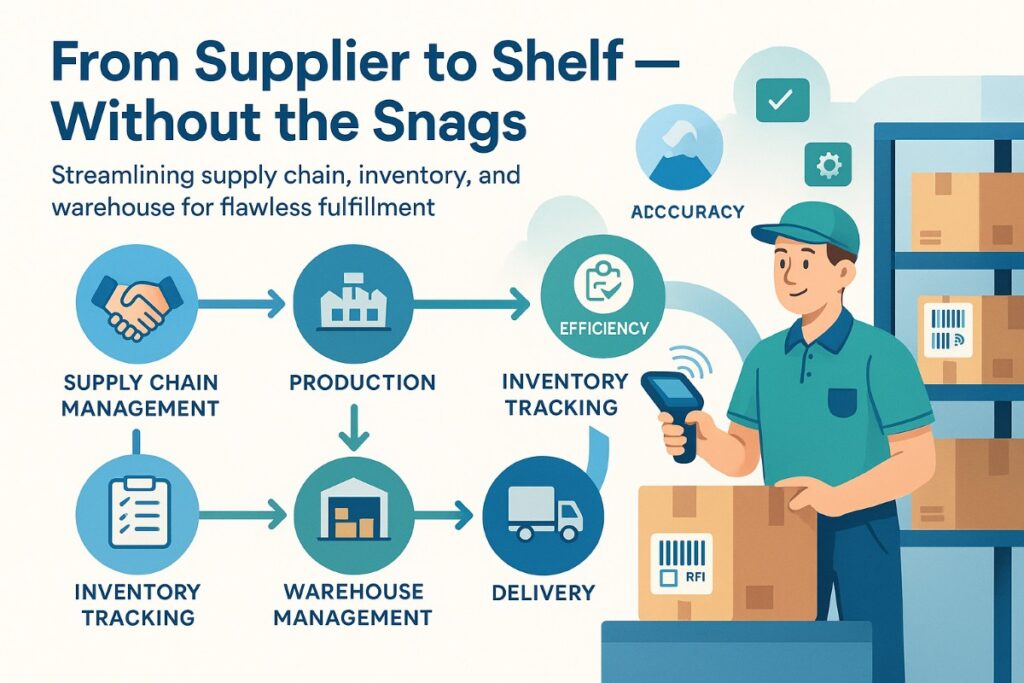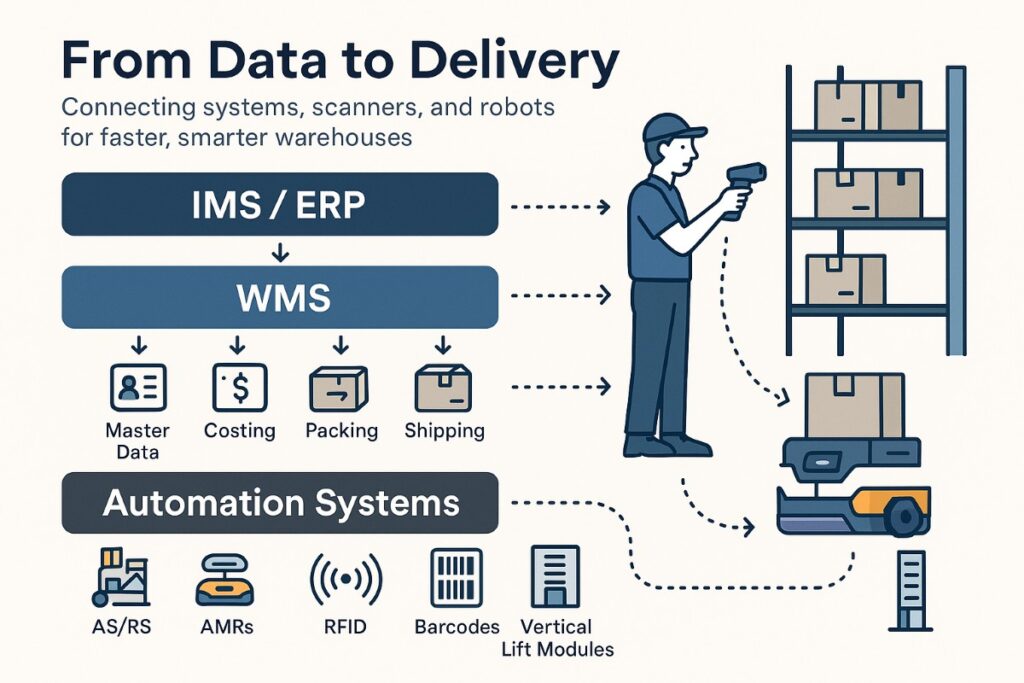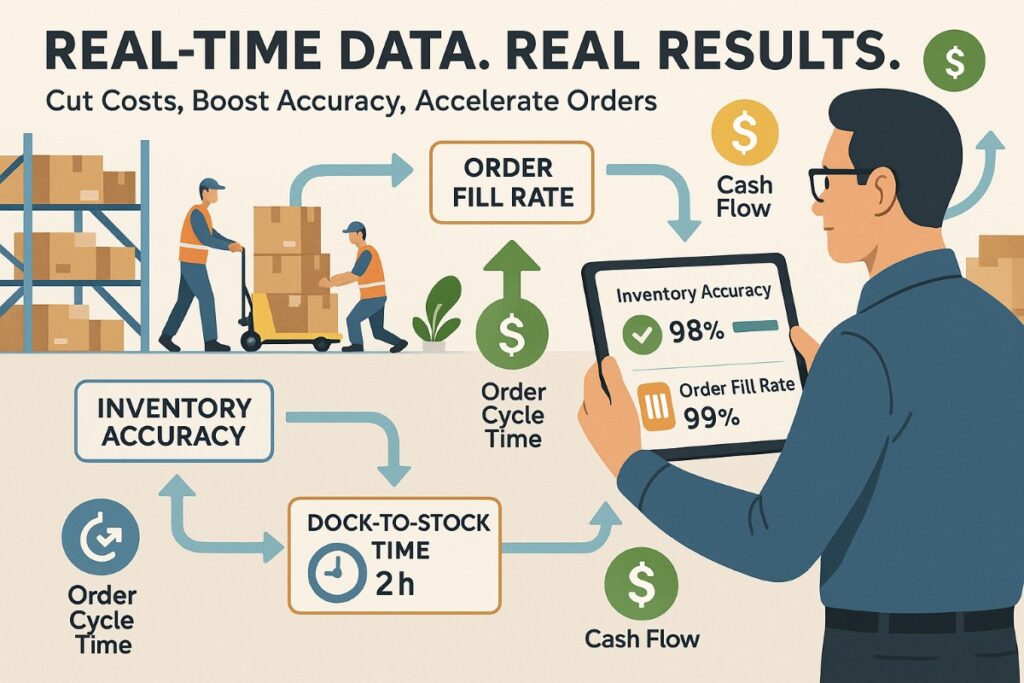Surprisingly, McKinsey found that 9 out of 10 companies faced supply chain challenges in 2024, revealing the fragility of fulfillment for U.S. businesses.
Real-time inventory tracking changes that picture by linking stock visibility with warehouse processes. Companies move from periodic checks to continuous, synchronized data that guides pickers, packers, and shippers. Systems such as IMS, WMS, ERP, RFID, barcodes, AMRs, and AS/RS share updates, enabling teams to act on reliable information quickly.
When availability is accurate, customers see fewer stockouts, faster shipments, and simpler returns. That raises satisfaction while cutting labor costs and error rates. The section frames how supply chain, inventory, and warehouse roles differ yet must align to scale profitably. It previews metrics to expect: higher accuracy, fewer pick errors, shorter cycle times, and better labor efficiency. Real-time tracking is presented as a practical path to resilience during demand shifts and a driver of lasting customer loyalty.
- Real-time visibility reduces stockouts and speeds order fulfillment.
- Integrated systems sync warehouse work with accurate stock data
- Improved accuracy drives lower costs, faster cycles, and higher satisfaction.
Defining the Playing Field: Supply Chain, Inventory Management, and Warehouse Management

Understanding where tasks begin and end in the supply chain helps teams reduce errors and speed deliveries.
Supply chain management coordinates procurement, production, stock levels, transport, and final delivery. It sets policy for safety stock, reorder points, and service targets that guide lower-level teams.
Inventory management balances demand with stock by forecasting, replenishing, and tracking inventory levels. The goal is to maintain cost control while avoiding overstock or stockouts that negatively impact the customer experience.
Warehouse management runs the physical side: storage layout, put-away, picking, packing, and shipping. A good design, labeling, and directed workflows reduce travel time and pick errors, supporting reliable order fulfillment.
Handoffs matter. Inventory policies shape slotting and cycle counts, while warehouse throughput feeds planning. Both rely on accurate data capture and integrated systems, such as barcode and RFID, to enable precise inventory control.
Common KPIs include inventory accuracy, pick errors, order fill rate, and labor efficiency. Clear role boundaries prevent duplication, align accountability, and prepare the organization to compare conventional approaches with real-time tracking.
Conventional Practices vs. Real-Time Tracking: What’s the Practical Difference?
Many operations still rely on periodic counts and manual logs, which often lag behind actual product movement.
Periodic counts and spreadsheets create gaps between recorded and physical stock. Delayed updates hide short-picks, misplaced units, or sudden demand spikes. That raises the risk of stockouts, over-ordering, and slow responses during peak periods.
Perpetual methods, such as barcode and RFID scanning, keep systems synchronized with the floor. Real-time syncing eliminates blind spots and enhances the tracking of inventory levels across multiple channels. Mobile scanning and point-of-scan validation cut human entry errors at the source.
Continuous cycle counting by the ABC class maintains accuracy without interrupting operations. With synchronized data, pick accuracy rises, returns drop, and exception handling speeds up for short-picks or substitutions.
Real-time visibility helps prevent safety-stock inflation by stabilizing stock levels and enabling proactive replenishment. Dynamic slotting and faster updates reduce cycle time and minimize upstream demand distortion, lowering the cost to serve while improving customer fulfillment.
Why Real-Time Matters for Customer Experience
Visible, up-to-the-minute stock information is a fast path from order to satisfied customer. A recent study found 24% of shoppers could not complete purchases due to stockouts, a direct hit to revenue and loyalty.
Linking live updates across inventory management and warehouse management systems reduces missed sales, abandoned carts, and split shipments. That single source of truth enables teams to act quickly and make informed decisions at checkout and during fulfillment.
Better visibility trims errors, speeds shipping, and raises on-time delivery rates. Accurate stock levels and proactive replenishment cut emergency expediting and lower related costs.
Higher accuracy and faster throughput improve cash flow by shrinking excess stock and speeding order-to-cash cycles. When 9 out of 10 companies report supply chain disruptions, resilient, data-driven operations become essential for businesses that want to protect their revenue.
Data analytics on demand patterns, returns, and service levels points teams to targeted fixes. For the customer, that means reliable promises—like buy-online-pickup—and a stronger impression of the brand.
Inside the Tech Stack: From IMS/WMS to RFID, Barcode, AMRs, and AS/RS

A practical tech stack links master records to scanners and robots, enabling teams to trust counts and act quickly.
An IMS and ERP hold master data, costing, and movement history. They create a single source of truth for stock levels and financial control. Mobile barcoding enhances the accuracy of point-of-scan transactions in those central records.
Inventory systems, ERP, and data analytics
Data analytics use real-time and historical signals to forecast demand and drive replenishment. That supports faster, evidence-based decisions. Clear transaction logs improve auditability for planners and finance teams.
Warehouse platforms, barcode/RFID, and directed picking
Warehouse management systems direct receiving, slotting, picking, packing, and shipping. For smaller operations, WMS-lite or mobile-first software delivers key capabilities faster and at lower cost.
Automation layers: AS/RS, AMRs, and storage modules
Automation, such as AS/RS, AMRs, carousels, and vertical lift modules, reduces travel time and increases throughput. Goods-to-person systems improve ergonomics and safety while boosting space utilization.
Integrations link IMS, WMS, and ERP, so every movement updates the central record. Together, these systems improve efficiency, accuracy, and service levels while lowering labor and storage costs.
Warehousing and Inventory Management: How Real-Time Tracking Elevates Each Function
Live stock updates bridge forecasting models with shop-floor actions, improving both speed and accuracy. This section highlights the practical benefits for planners and floor teams when signals are transmitted without delay.
Inventory Gains: Forecasting, Safety Stock, EOQ, ABC, Cycle Counts
Real-time feeds enhance demand forecasts and streamline replenishment, minimizing excess stock while reducing stockouts. Safety stock is set using live consumption and lead-time variability rather than fixed rules.
EOQ uses the classic formula EOQ = √((2DS)/H) and benefits when D and lead-time inputs refresh automatically. ABC-driven cycle counting raises ongoing accuracy without shutdowns and focuses effort where errors hurt most.
JIT or hybrid strategies work better with dependable visibility and strong supplier performance, lowering carrying costs without raising risk.
Operations Gains: Put-away, Picking Accuracy, Packing, Shipping Velocity
Within warehouse processes, clear labeling, velocity-based slotting, and guided put-away cut travel time. Directed picking with barcode or RFID verification, voice, and put-to-light boosts pick accuracy.
Standardized packing checks and automated label generation speed shipping and reduce returns. Continuous feedback loops align planning with floor constraints, improving order fulfillment, lowering cost to serve, and strengthening customer experience.
Comparative Impact on Metrics: Accuracy, Costs, Cash Flow, and Order Cycle Time

When systems stream updates instantly, teams spot errors sooner and fix problems before customers notice.
KPIs to track
Key metrics include inventory accuracy, order fill rate, pick error rate, order cycle time, labor efficiency, and dock-to-stock time.
Integrated management systems provide a single source of truth, so KPI numbers stay reliable and timely.
Tangible Financial Outcomes
Higher accuracy cuts reships and returns, which lowers direct costs and improves customer satisfaction.
Reduced excess stock trims and carrying costs and frees working capital, which boosts cash flow and profitability.
Operational Gains
Directed work reduces travel, cuts touches, and lifts throughput per labor hour for measurable efficiency gains.
Clear exception visibility, short shipments or damage, hidden costs, and lower escalations.
Unified data lets leaders make informed, fast decisions, benchmark performance, and tune processes across supply chain, inventory management, and warehouse management. The bottom line is that real-time practices produce measurable, sustained improvements in cost control, cycle time, and profit. In today’s fast-paced markets, warehousing and inventory management work best when they operate as a single, data-driven system.
Integration Roadmap: Unifying Systems to Make Informed, Real-Time Decisions
A clear integration path helps teams turn scattered data into timely actions that improve fulfillment.
Bridging IMS, WMS, and ERP for a single source of truth
ERP centralizes procedures and serves as the system of record for quantities, costs, and movements. Barcode and mobile scanning extend that record to the point of work. Connecting IMS and warehouse management systems ensures everyone sees the exact quantities, locations, and status.
Phased Adoption: From Manual and Basic Systems to WMS-lite and Advanced Automation
Start with master-data standards, barcode capture, and digital receiving. Then add a WMS-lite for directed picking, optimized routes, and packing checks. Transition to complete WMS and automation, including AMRs, AS/RS, and VLMs, once processes and data governance are proven stable.
Use APIs and event streams to sync transactions reliably. Mobile point-of-scan tools reduce latency and human error, enabling operations to react faster. This staged approach provides businesses with quick wins while building scale, resilience, and the ability to make informed decisions in real-time.
Moving Forward with Confidence: Building a Resilient, Customer-Centric Operation
Practical steps toward achieving real-time visibility yield steady improvements in accuracy, speed, and cash flow.
Teams should align inventory and management rules with a simple scanning discipline. Start small: fix master data, enforce point-of-scan checks, and then scale tools as results appear.
Adopt flexible warehouse systems and software that support growth. Use mobile barcoding, RFID, AS/RS, and VLMs to boost pick accuracy and space use while keeping safety high.
Maintain continuous improvement through cycle counts, KPI reviews, and scenario planning with data analytics. This approach reduces costs, improves cash flow, and raises customer service levels.
Move in phases, prioritize resilience, and measure customer-centered metrics as the North Star for long-term competitiveness.



%201.png)

%201.png)

%201.png)

